Characterization of a Thermal Insulating Material Based on a Wheat Straw and Recycled Paper Cellulose to Be Applied in Buildings by Blowing Method
Abstract
1. Introduction
2. Materials and Methods
2.1. Materials
2.2. Chemical Composition
2.3. Thermal Stability
2.4. Infrared Spectroscopy Analysis
2.5. Surface Analysis
2.6. Sample Preparation
2.7. Thermal Conductivity
2.8. Biological Resistance
2.9. Fire Behavior
3. Results
3.1. Chemical Composition
3.1.1. Paper Cellulose
3.1.2. Wheat Straw
3.2. Thermal Stability
3.3. Infrared Spectroscopy Analysis
3.4. Surface Analysis
3.4.1. Paper Cellulose
3.4.2. Wheat Straw
3.5. Thermal Conductivity
3.6. Biological Resistance
3.7. Fire Behavior
4. Discussion
5. Conclusions
Author Contributions
Funding
Institutional Review Board Statement
Informed Consent Statement
Data Availability Statement
Acknowledgments
Conflicts of Interest
References
- Zhou, Y.; Trabelsi, A.; El Mankibi, M. A review on the properties of straw insulation for buildings. Constr. Build. Mater. 2022, 330, 127215. [Google Scholar] [CrossRef]
- Soto, M.; Vera, M.; Parra, K.; Rojas, C.; Cárdenas, J.P. Potential of the Residual Fibers of Pisum Sativum (PS), for use in a Development of a Thermal Insulator Material. IOP Conf. Ser. Earth Environ. Sci. 2020, 503, 012084. [Google Scholar] [CrossRef]
- Asdrubali, F.; Alessandro, F.D.; Schiavoni, S. A review of unconventional sustainable building insulation materials. Sustain. Mater. Technol. 2015, 4, 1–17. [Google Scholar] [CrossRef]
- Ramesh, T.; Prakash, R.; Shukla, K.K. Life cycle energy analysis of buildings: An overview. Energy Build. 2010, 42, 1592–1600. [Google Scholar] [CrossRef]
- Papadopoulos, A.M. State of the art in thermal insulation materials and aims for future developments. Energy Build. 2005, 37, 77–86. [Google Scholar] [CrossRef]
- Abu-jdayil, B.; Mourad, A.; Hittini, W.; Hassan, M.; Hameedi, S. Traditional, state-of-the-art and renewable thermal building insulation materials: An overview. Constr. Build. Mater. 2019, 214, 709–735. [Google Scholar] [CrossRef]
- Rojas, C.; Cea, M.; Iriarte, A.; Valdés, G.; Navia, R.; Cárdenas-R, J.P. Thermal insulation materials based on agricultural residual wheat straw and corn husk biomass, for application in sustainable buildings. Sustain. Mater. Technol. 2019, 17, e00102. [Google Scholar] [CrossRef]
- Mansour, E.; Loxton, C.; Elias, R.M.; Ormondroyd, G.A. Assessment of health implications related to processing and use of natural wool insulation products. Environ. Int. 2014, 73, 402–412. [Google Scholar] [CrossRef]
- Asif, M.; Muneer, T.; Kelley, R. Life cycle assessment: A case study of a dwelling home in Scotland. Build. Environ. 2007, 42, 1391–1394. [Google Scholar] [CrossRef]
- Ntimugura, F.; Vinai, R.; Harper, A.; Walker, P. Mechanical, thermal, hygroscopic and acoustic properties of bio-aggregates—Lime and alkali—Activated insulating composite materials: A review of current status and prospects for miscanthus as an innovative resource in the South West of England. Sustain. Mater. Technol. 2020, 26, e00211. [Google Scholar] [CrossRef]
- Schiavoni, S.; D’Alessandro, F.; Bianchi, F.; Asdrubali, F. Insulation materials for the building sector: A review and comparative analysis. Renew. Sustain. Energy Rev. 2016, 62, 988–1011. [Google Scholar] [CrossRef]
- Zach, J.; Hroudová, J.; Korjenic, A. Environmentally efficient thermal and acoustic insulation based on natural and waste fibers. J. Chem. Technol. Biotechnol. 2016, 91, 2156–2161. [Google Scholar] [CrossRef]
- Reif, M.; Zach, J.Ĝ.; Hroudová, J. Studying the properties of particulate insulating materials on natural basis. Procedia Eng. 2016, 151, 368–374. [Google Scholar] [CrossRef]
- Palumbo, M.; Avellaneda, J.; Lacasta, A.M. Availability of crop by-products in Spain: New raw materials for natural thermal insulation. Resour. Conserv. Recycl. 2015, 99, 1–6. [Google Scholar] [CrossRef]
- Liuzzi, S.; Sanarica, S.; Liuzzi, S.; Stefanizzi, P. Use of agro-wastes in building materials in the Mediterranean area: Use of agro-wastes in building materials in the Mediterranean area: A review a review Assessing the feasibility of using the heat Sanarica district temperatu. Energy Procedia 2017, 126, 242–249. [Google Scholar] [CrossRef]
- Janowska-renkas, E.; Król, A.; Pochwała, S.; Pałubski, D.; Adamska, M.; Klementowski, I. The Fire Resistance and Heat Conductivity of Natural Construction Material Based on Straw and Numerical Simulation of Building Energy Demand. Energies 2022, 15, 1155. [Google Scholar] [CrossRef]
- Zou, S.; Li, H.; Liu, L.; Wang, S.; Zhang, X.; Zhang, G. Experimental study on fire resistance improvement of wheat straw composite insulation materials for buildings. J. Build. Eng. 2021, 43, 103172. [Google Scholar] [CrossRef]
- Miron, I.O.; Manea, D.L.; Cantor, D.M.; Aciu, C. Organic Thermal Insulation Based on Wheat Straw. Procedia Eng. 2017, 181, 674–681. [Google Scholar] [CrossRef]
- Stanislas, T.T.; Tendo, J.F.; Teixeira, R.S.; Ojo, E.B.; Komadja, G.C.; Kadivar, M.; Junior, H.S. Effect of cellulose pulp fibres on the physical, mechanical, and thermal performance of extruded earth-based materials. J. Build. Eng. 2021, 39, 102259. [Google Scholar] [CrossRef]
- Fedorik, F.; Zach, J.; Lehto, M.; Kymäläinen, H.R.; Kuisma, R.; Jallinoja, M.; Illikainen, K.; Alitalo, S. Hygrothermal properties of advanced bio-based insulation materials. Energy Build. 2021, 253, 111528. [Google Scholar] [CrossRef]
- Wu, K.; Wu, H.; Wang, R.; Yan, X.; Sun, W.; Liu, Y.; Kuang, Y.; Jiang, F.; Chen, S. The use of cellulose fiber from office waste paper to improve the thermal insulation-related property of konjac glucomannan/starch aerogel. Ind. Crops Prod. 2022, 177, 114424. [Google Scholar] [CrossRef]
- Rojas, C.; Cea, M.; Rosas-Díaz, F.; Cárdenas-R, J. Physical, chemical and mechanical characterization of a prototype insulating material based on eucalyptus bark fiber. IEEE Lat. Am. Trans. 2018, 16, 2441–2446. [Google Scholar] [CrossRef]
- Csanády, D.; Fenyvesi, O.; Nagy, B. Heat transfer in straw-based thermal insulating materials. Materials 2021, 14, 4408. [Google Scholar] [CrossRef] [PubMed]
- Korjenic, A.; Petránek, V. Development and performance evaluation of natural thermal-insulation materials composed of renewable resources. Energy Build. 2011, 43, 2518–2523. [Google Scholar] [CrossRef]
- Bakatovich, A.; Gaspar, F. Composite material for thermal insulation based on moss raw material. Constr. Build. Mater. 2019, 228, 116699. [Google Scholar] [CrossRef]
- Viel, M.; Collet, F.; Prétot, S.; Lanos, C. Hemp-straw composites: Gluing study and multi-physical characterizations. Materials 2019, 12, 1199. [Google Scholar] [CrossRef]
- Fariha, S.; Chowdhury, F.I.; Rahman, M.R.; Bakri, M.K. Bin Development of pulp and paper waste-recycled plastic biocomposites. In Recycled Plastic Biocomposites; Woodhead Publishing: Sawston, UK, 2022; pp. 51–79. [Google Scholar] [CrossRef]
- Thai, Q.B.; Chong, R.O.; Nguyen, P.T.T.; Le, D.K.; Le, P.K.; Phan-Thien, N.; Duong, H.M. Recycling of waste tire fibers into advanced aerogels for thermal insulation and sound absorption applications. J. Environ. Chem. Eng. 2020, 8, 104279. [Google Scholar] [CrossRef]
- Damico, F.C.; Alvarado, R.G.; Kelly, M.T.; Oyola, O.E.; Oyola, O.E.; Diaz, M. Análisis energético de las viviendas del centro-sur de Chile. Arquiteturarevista 2012, 8, 62–75. [Google Scholar] [CrossRef]
- Armijo, G.; Whitman, C.; Roubelat, L. Reacondicionamiento térmico en Temuco-Padre las Casas, Chile: Una ciudad declarada saturada por contaminacion aérea. Presented at XII ENCAC VIII ELACAC; Brasilia, Brazil, 25–27 September 2013; pp. 1–10. [Google Scholar]
- Castro, C.; Brignardello, L. El Estado Del Medio Ambiente En Chile. Estud Geogr 1999, 234, 139–155. [Google Scholar]
- Cárdenas-R, J.P.; Cea, M.; Santín, K.; Valdés, G.; Hunter, R.; Navia, R. Characterization and application of a natural polymer obtained from Hydrangea macrophylla as a thermal insulation biomaterial. Compos. Part B Eng. 2018, 132, 10–16. [Google Scholar] [CrossRef]
- Cárdenas-R, J.P. Thermal Insulation Biomaterial Based on Hydrangea Macrophylla. In Bio-Based Materials and Biotechnologies for Eco-Efficient Construction; Pacheco-Torgal, F., Ivanov, V., Tsang, D.C.W., Eds.; Woodhead Publishing Series in Civil and Structural Engineering; Woodhead Publishing: Sawston, UK, 2020; pp. 187–201. ISBN 978-0-12-819481-2. [Google Scholar]
- Mehrez, I.; Hachem, H.; Jemni, A. Thermal insulation potential of wood-cereal straws/plaster composite. Case Stud. Constr. Mater. 2022, 17, e01353. [Google Scholar] [CrossRef]
- El Kanzaoui, M.; Ennawaoui, C.; Eladaoui, S.; Hajjaji, A.; Guenbour, A.; Boussen, R. Study of the physical behavior of a new composite material based on fly ash from the combustion of coal in an ultra-supercritical thermal power plant. J. Compos. Sci. 2021, 5, 151. [Google Scholar] [CrossRef]
- TAPPI Standard. Anexo I, Caracterización Química de los Residuos Agroindustriales 2007. Available online: https://es.scribd.com/document/317501564/ANEXO-I-Tappi-1 (accessed on 4 March 2022).
- Kök, M.V.K.; Varfolomeev, M.A.; Nurgaliev, D.K. Crude oil characterization using TGA-DTA, TGA-FTIR and TGA-MS techniques. J. Pet. Sci. Eng. 2017, 154, 537–542. [Google Scholar] [CrossRef]
- Technical Specifications. Innovative, Intuitive, Reliable. 1–2. Available online: https://gsi-lab.com/wp-content/uploads/2016/10/Agilent-FTIR-Cary-630.pdf (accessed on 27 June 2022).
- Rios-Reina, R.; Callejón, R.M.; Oliver-Pozo, C.; Amigo, J.M.; García-Gonzalez, D.L. ATR-FTIR as a potential tool for controlling high quality vinegar categories. Food Control 2017, 78, 230–237. [Google Scholar] [CrossRef]
- de Assumpção Pereira-da-Silva, M.; Ferri, F.A. 1—Scanning Electron Microscopy. Nanocharacterization Tech. 2017, 1, 1–35. [Google Scholar] [CrossRef]
- Barbieri, V.; Lassinantti Gualtieri, M.; Siligardi, C. Wheat husk: A renewable resource for bio-based building materials. Constr. Build. Mater. 2020, 251, 118909. [Google Scholar] [CrossRef]
- Pianella, A.; Clarke, R.E.; Williams, N.S.G.; Chen, Z.; Aye, L. Steady-state and transient thermal measurements of green roof substrates. Energy Build. 2016, 131, 123–131. [Google Scholar] [CrossRef]
- Wonorahardjo, S.; Sutjahja, I.M.; Mardiyati, Y.; Andoni, H.; Achsani, R.A.; Steven, S.; Thomas, D.; Tunçbilek, E.; Arıcı, M.; Rahmah, N.; et al. Effect of different building façade systems on thermal comfort and urban heat island phenomenon: An experimental analysis. Build. Environ. 2022, 217, 109063. [Google Scholar] [CrossRef]
- Std 442-1981; IEEE Guide for Soil Thermal Resistivity Measurements. IEEE: Piscataway, NJ, USA, 1980; pp. 1––16. Available online: https://standards.ieee.org/ieee/442/6891/ (accessed on 27 June 2022).
- D5334-00; Standard Test Method for Determination of Thermal Conductivity of Soil and Soft Rock by Thermal Needle Probe Procedure. ASTM International: West Conshohocken, PA, USA, 2017. [CrossRef]
- Hermosilla, E.; Rubilar, O.; Schalchli, H.; da Silva, A.S.A.; Ferreira-Leitao, V.; Diez, M.C. Sequential white-rot and brown-rot fungal pretreatment of wheat straw as a promising alternative for complementary mild treatments. Waste Manag. 2018, 79, 240–250. [Google Scholar] [CrossRef]
- Asociación Española de Normalización y Certificación. UNE 23-725-90: Ensayos de reacción al fuego de los materiales de construcción. In Ensayo de Goteo Aplicable a los Materiales Fusibles; Ensayo complementario; AENOR: Madrid, Spain, 1990; p. 725. [Google Scholar]
- Lopez Hurtado, P.; Rouilly, A.; Vandenbossche, V.; Raynaud, C. A review on the properties of cellulose fibre insulation. Build. Environ. 2016, 96, 170–177. [Google Scholar] [CrossRef]
- Raza, M.; Al Abdallah, H.; Abdullah, A.; Abu-Jdayil, B. Date Palm Surface Fibers for Green Thermal Insulation. Buildings 2022, 12, 866. [Google Scholar] [CrossRef]
- Abu-Jdayil, B.; Mourad, A.H.I.; Hussain, A.; Al Abdallah, H. Thermal insulation and mechanical characteristics of polyester filled with date seed wastes. Constr. Build. Mater. 2022, 315, 125805. [Google Scholar] [CrossRef]
- Gama, N.; Godinho, B.; Barros-Timmons, A.; Ferreira, A. PU/Lignocellulosic Composites Produced from Recycled Raw Materials. J. Polym. Environ. 2022, 30, 194–205. [Google Scholar] [CrossRef]
- Siqueira, F.F.D.S.; Cosse, R.L.; de Noronha Castro Pinto, F.A.; Mareze, P.H.; Silva, C.F.E.; Nunes, L.C.C. Characterization of buriti (Mauritia flexuosa) foam for thermal insulation and sound absorption applications in buildings. Buildings 2021, 11, 292. [Google Scholar] [CrossRef]
- Ahmed, A.; Qayoum, A.; Mir, F.Q. Spectroscopic studies of renewable insulation materials for energy saving in building sector. J. Build. Eng. 2021, 44, 103300. [Google Scholar] [CrossRef]
- Charai, M.; Sghiouri, H.; Mezrhab, A.; Karkri, M. Thermal insulation potential of non-industrial hemp (Moroccan cannabis sativa L.) fibers for green plaster-based building materials. J. Clean. Prod. 2021, 292, 126064. [Google Scholar] [CrossRef]
- Cintura, E.; Nunes, L.; Esteves, B.; Faria, P. Agro-industrial wastes as building insulation materials: A review and challenges for Euro-Mediterranean countries. Ind. Crops Prod. 2021, 171, 113833. [Google Scholar] [CrossRef]
- Sałasińska, K.; Leszczyńska, M.; Celiński, M.; Kozikowski, P.; Kowiorski, K.; Lipińska, L. Burning behaviour of rigid polyurethane foams with histidine and modified graphene oxide. Materials 2021, 14, 1184. [Google Scholar] [CrossRef]
- Zhao, W.; Yan, W.; Zhang, Z.; Gao, H.; Zeng, Q.; Du, G.; Fan, M. Development and performance evaluation of wood-pulp/glass fibre hybrid composites as core materials for vacuum insulation panels. J. Clean. Prod. 2022, 357, 131957. [Google Scholar] [CrossRef]
- Bovo, M.; Giani, N.; Barbaresi, A.; Mazzocchetti, L.; Barbaresi, L.; Giorgini, L.; Torreggiani, D.; Tassinari, P. Contribution to thermal and acoustic characterization of corn cob for bio-based building insulation applications. Energy Build. 2022, 262, 111994. [Google Scholar] [CrossRef]
- Reibert, D.; Tzanetos, F.; Sydow, S.; Bialuch, I.; Lee, T.H.; Abraham, T.G.; Zontar, D.; Brecher, C. Integration of Bio-based Insulation Materials as a Contribution to the Biological Transformation of Production Technology. Procedia CIRP 2022, 110, 305–310. [Google Scholar] [CrossRef]
- Antolinc, D.; Filipič, K.E. Recycling of nonwoven polyethylene terephthalate textile into thermal and acoustic insulation for more sustainable buildings. Polymers 2021, 13, 3090. [Google Scholar] [CrossRef] [PubMed]
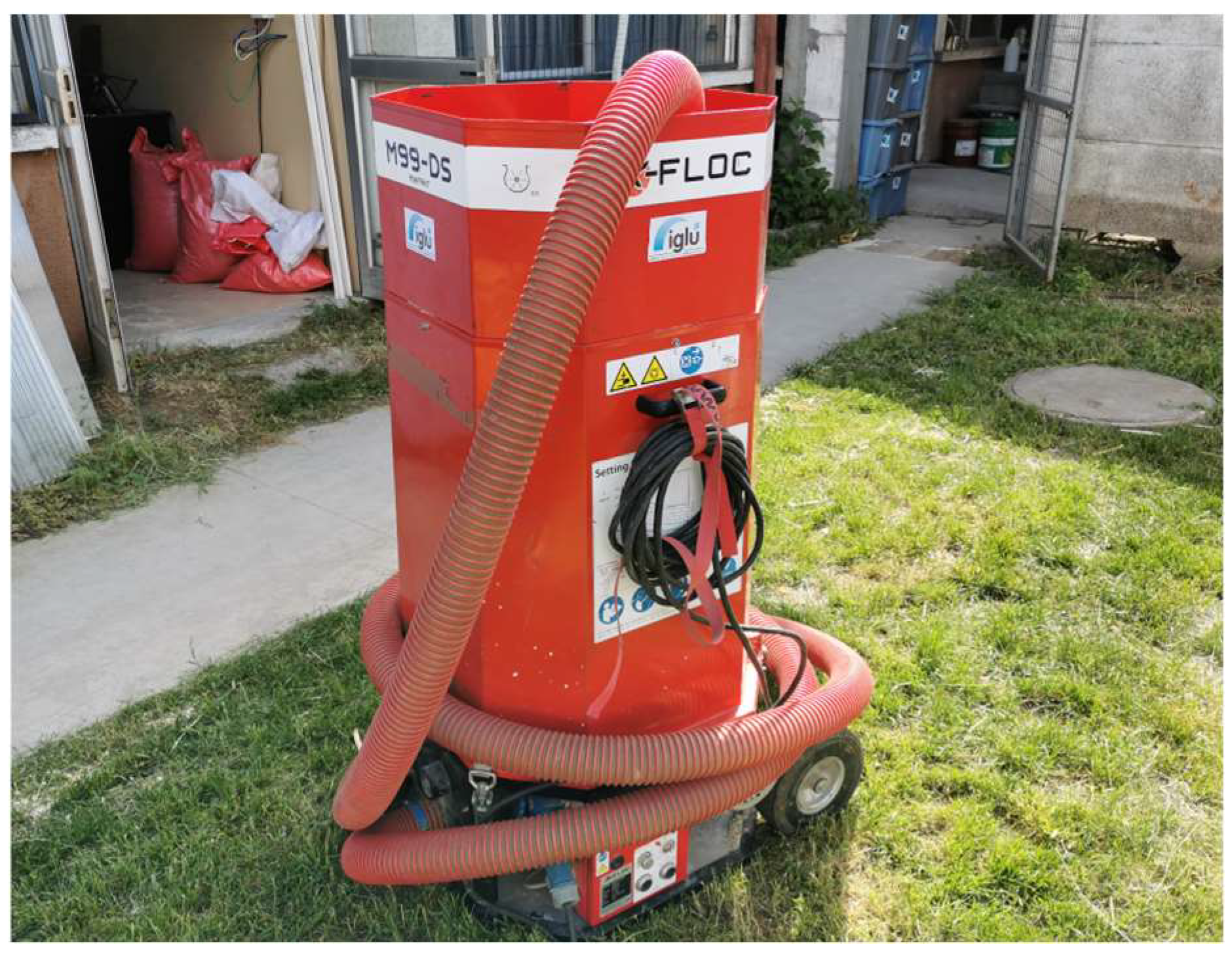
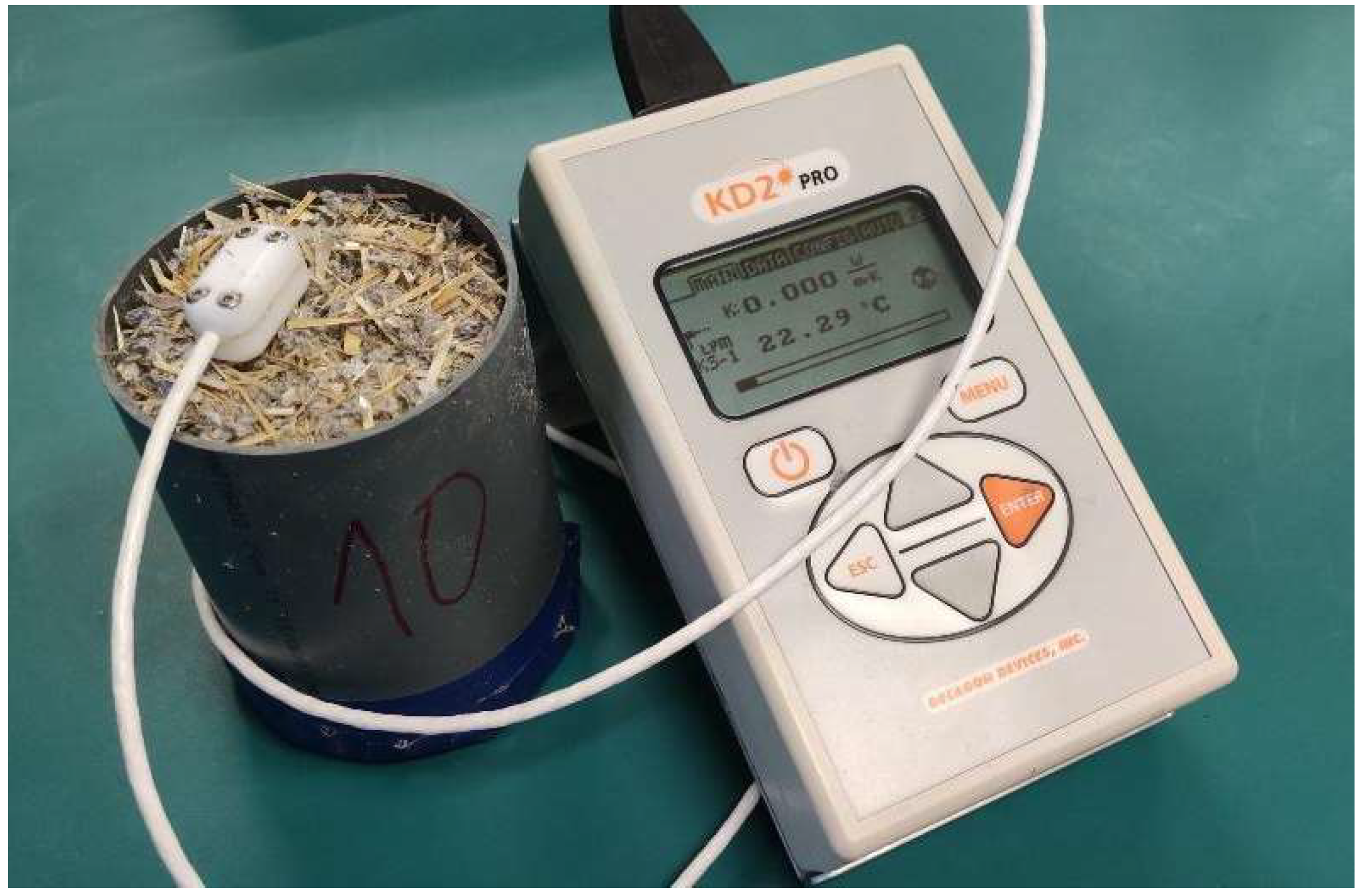



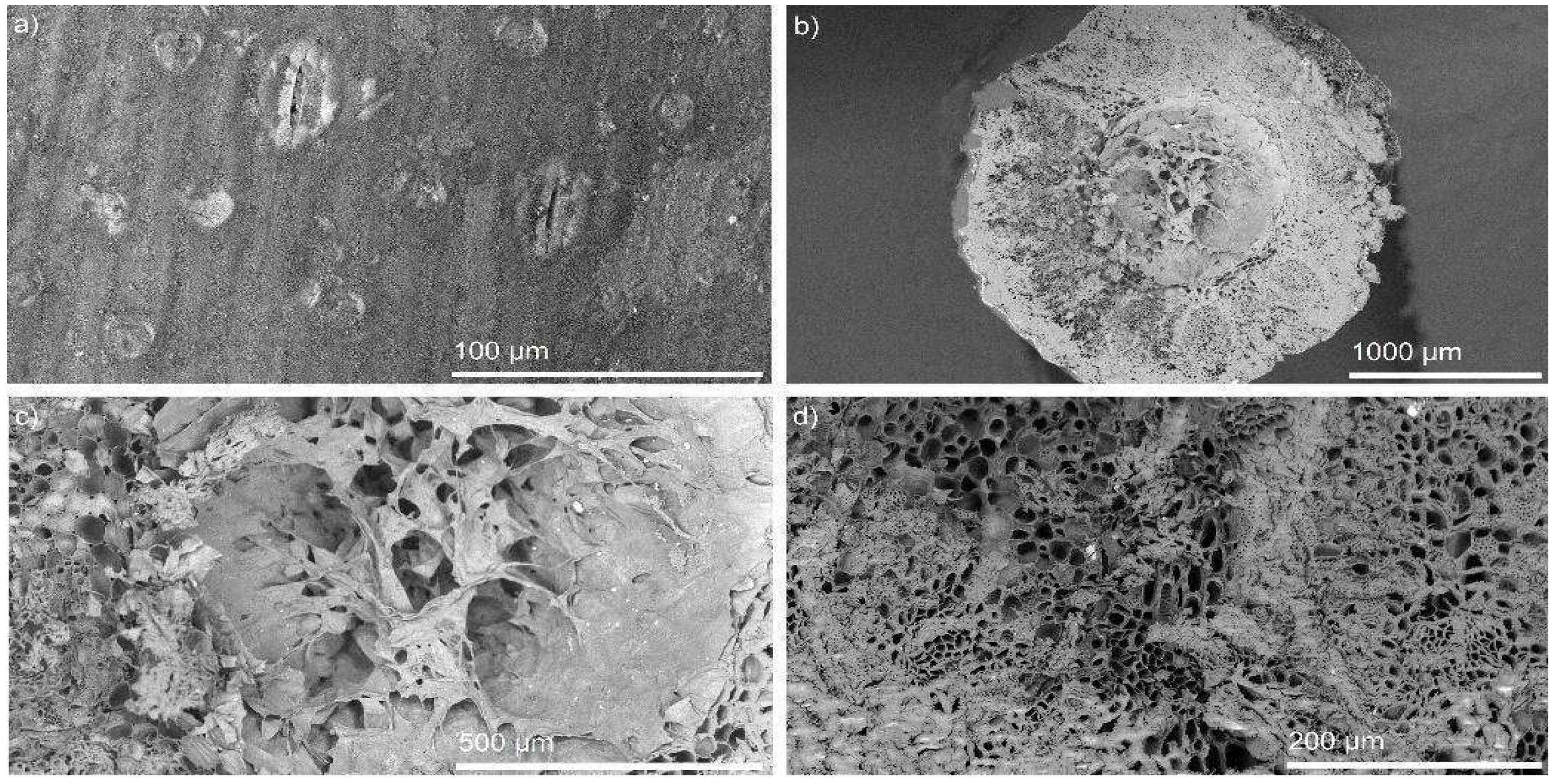

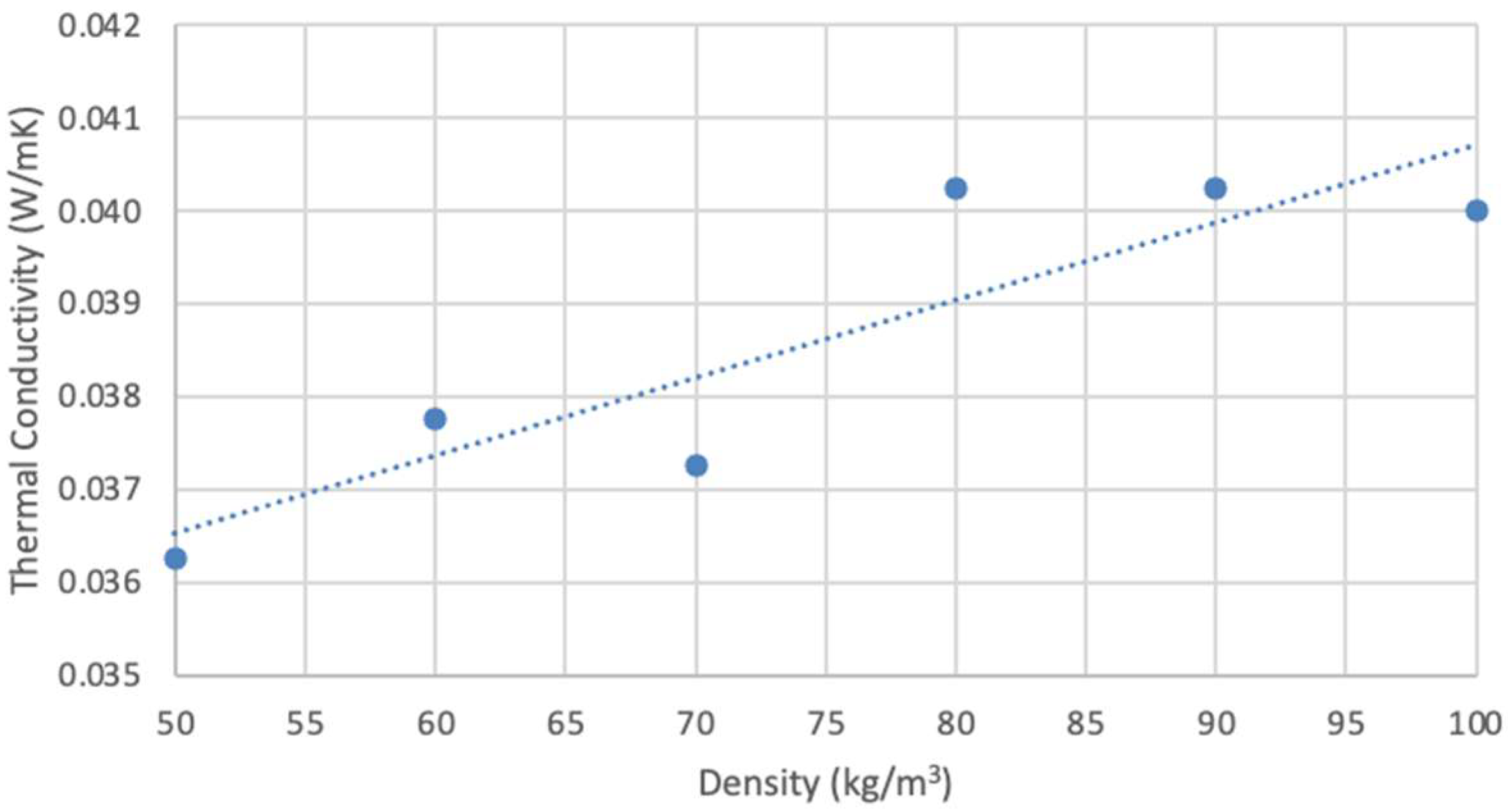

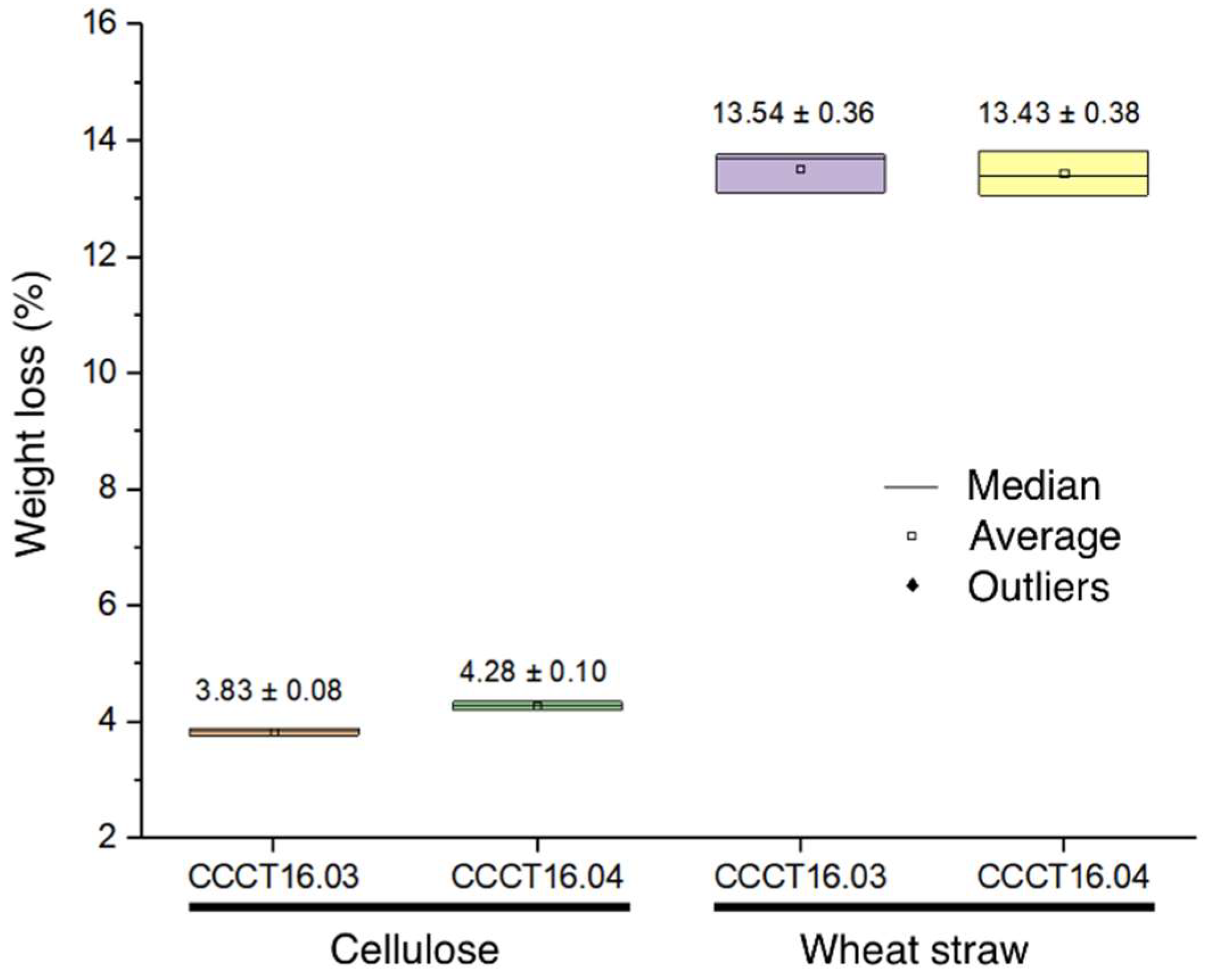
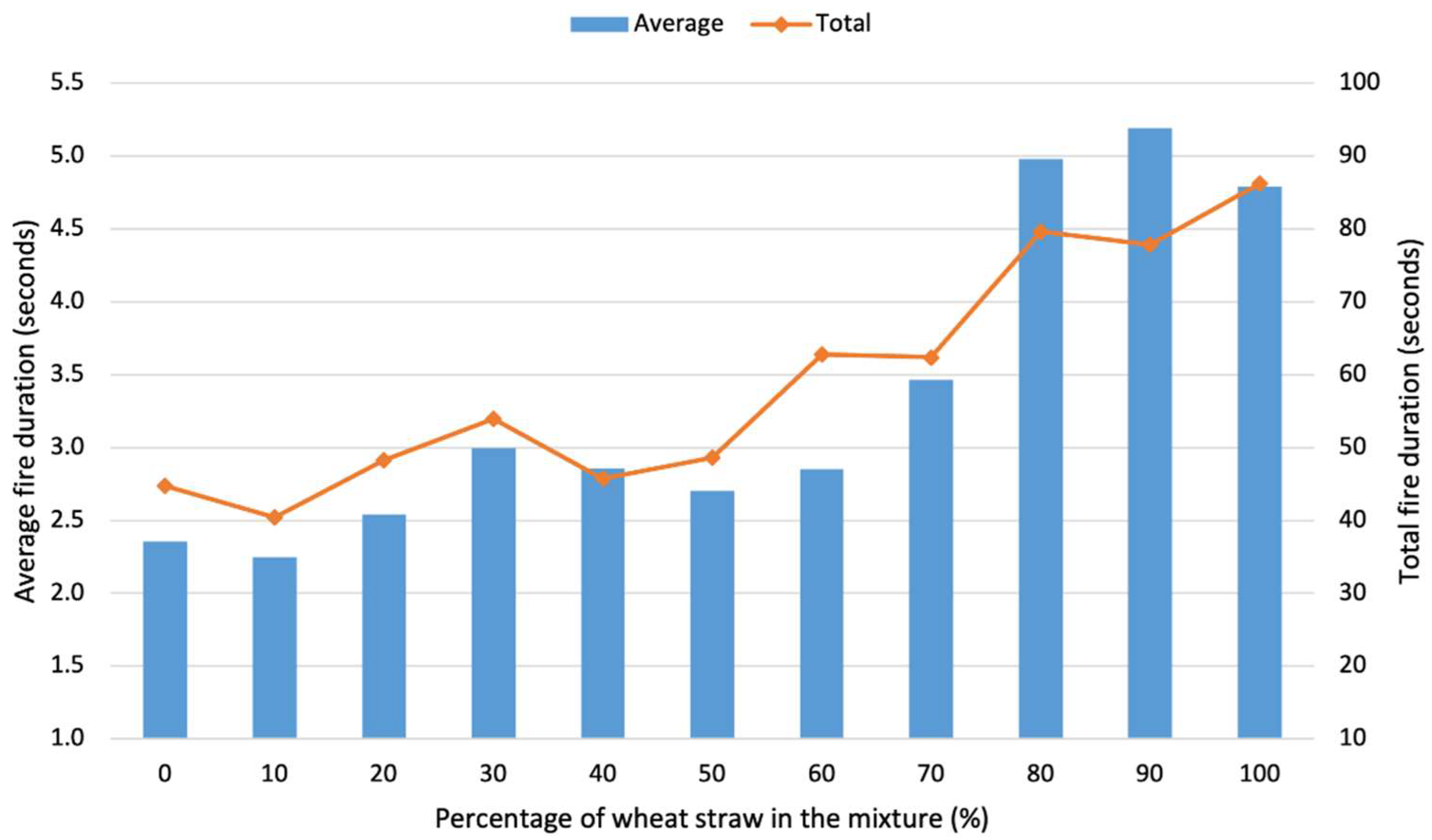
| Component (%) | Sample | Average | ||
|---|---|---|---|---|
| S1 | S2 | S3 | ||
| Moisture | 8.36 | 9.06 | 9.01 | 8.81 ± 0.17% |
| Ashes | 15.16 | 15.27 | 15.11 | 15.18 ± 0.08% |
| Removable compounds | 25.51 | 25.71 | 25.49 | 25.57 ± 0.12% |
| Lignin | 22.70 | 22.32 | 22.11 | 22.38 ± 0.30% |
| Holocellulose | 65.73 | 67.79 | 65.83 | 66.45 ± 1.16% |
| α-Cellulose | 49.28 | 51.80 | 46.14 | 49.07 ± 2.84% |
| Hemicellulose | 16.45 | 15.99 | 19.68 | 17.37 ± 2.01% |
| Component (%) | Sample | Average | ||
|---|---|---|---|---|
| S1 | S2 | S3 | ||
| Moisture | 9.33 | 9.06 | 9.03 | 9.14 ± 0.17% |
| Ashes | 4.32 | 4.45 | 4.34 | 4.37 ± 0.07% |
| Removable compounds | 11.47 | 11.71 | 11.75 | 11.64 ± 0.15% |
| Lignin | 18.59 | 18.90 | 18.81 | 18.77 ± 0.16% |
| Holocellulose | 69.57 | 69.04 | 69.43 | 69.35 ± 0.27% |
| α-Cellulose | 34.84 | 33.71 | 33.96 | 34.17 ± 0.59% |
| Hemicellulose | 34.73 | 35.33 | 35.47 | 35.18 ± 0.39% |
Disclaimer/Publisher’s Note: The statements, opinions and data contained in all publications are solely those of the individual author(s) and contributor(s) and not of MDPI and/or the editor(s). MDPI and/or the editor(s) disclaim responsibility for any injury to people or property resulting from any ideas, methods, instructions or products referred to in the content. |
© 2022 by the authors. Licensee MDPI, Basel, Switzerland. This article is an open access article distributed under the terms and conditions of the Creative Commons Attribution (CC BY) license (https://creativecommons.org/licenses/by/4.0/).
Share and Cite
Soto, M.; Rojas, C.; Cárdenas-Ramírez, J.P. Characterization of a Thermal Insulating Material Based on a Wheat Straw and Recycled Paper Cellulose to Be Applied in Buildings by Blowing Method. Sustainability 2023, 15, 58. https://doi.org/10.3390/su15010058
Soto M, Rojas C, Cárdenas-Ramírez JP. Characterization of a Thermal Insulating Material Based on a Wheat Straw and Recycled Paper Cellulose to Be Applied in Buildings by Blowing Method. Sustainability. 2023; 15(1):58. https://doi.org/10.3390/su15010058
Chicago/Turabian StyleSoto, Matías, Carlos Rojas, and Juan Pablo Cárdenas-Ramírez. 2023. "Characterization of a Thermal Insulating Material Based on a Wheat Straw and Recycled Paper Cellulose to Be Applied in Buildings by Blowing Method" Sustainability 15, no. 1: 58. https://doi.org/10.3390/su15010058
APA StyleSoto, M., Rojas, C., & Cárdenas-Ramírez, J. P. (2023). Characterization of a Thermal Insulating Material Based on a Wheat Straw and Recycled Paper Cellulose to Be Applied in Buildings by Blowing Method. Sustainability, 15(1), 58. https://doi.org/10.3390/su15010058








